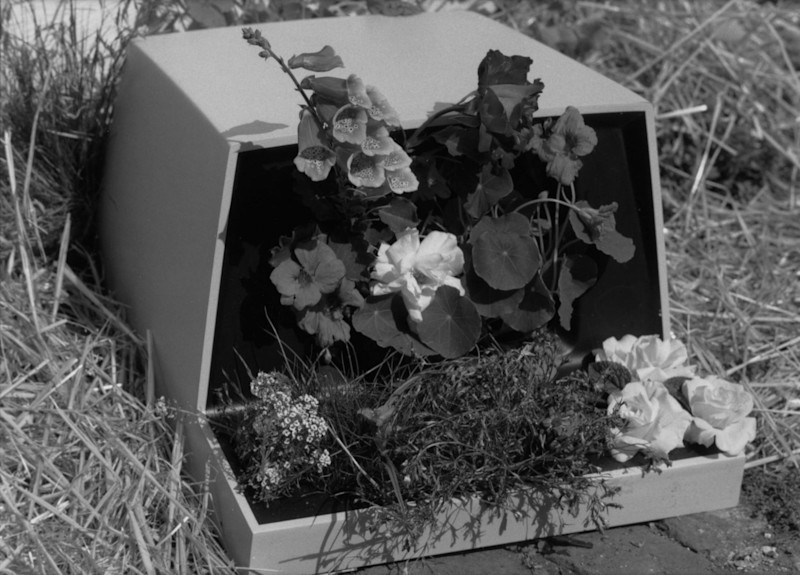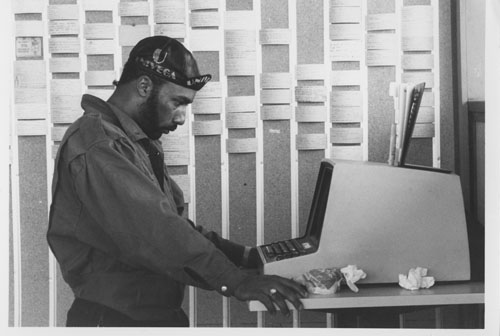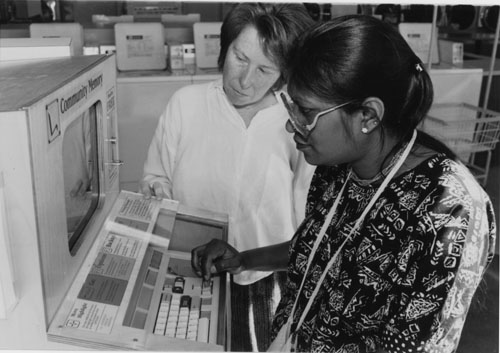Are.na Annual
On Community Memory
5/19/2022
Mike Tully

In the early 1970s in Berkeley, California, Lee Felsenstein, a computer science drop-out from UC Berkeley, started thinking about a more technological approach to community organizing. Felsenstein had participated in the Free Speech Movement and anti-Vietnam War protests in the years prior and saw potential in the computer for efficiently bringing people together for social change. But at the time, computers were typically only found in government agencies and research institutions, not accessible to the general public.
One notable exception was at the technological commune Project One, housed in an abandoned candy factory in San Francisco and initiated by a former student of Buckminster Fuller. Project One served as the live/work headquarters for Resource One, a "non-profit community group sharing resources and skills.”1 The group had acquired its own computer, and by the time Felsenstein joined in 1972, it was experimenting with using this new technology to empower individuals through a decentralized system. Along with several other members, he started to work on what would eventually enact their ambitions: the Community Memory Project. Felsenstein recounts, “we opened the door to cyberspace and found that it was hospitable territory.”2
The primary aim of the Community Memory Project was to provide people with access to a computer, in order to use it for exchanging information within their own community. The group did this through the creation of what they called “terminals”—essentially, a publicly accessible computer that could be used as an electronic bulletin board. For many people who encountered the initial terminals, it was their first experience with a computer, and they made use of them in ways that Felsenstein and his collaborators didn't expect. A local theater critic recounted years later how he had learned how to write as a teenager via his local terminal. The first proto-troll masqueraded in posts as Benway, a recurring character in the stories of William Burroughs. Informal teaching took place between groups, and poetry and typewriter graphics began to appear. By staging their experiment in public spaces, the Community Memory Project explored how an information portal could be a shared experience, an exchange between participants in which the information circulated was as expansive as the community itself.
Over the course of nearly 20 years, the group set up terminals across the Bay area in co-ops, libraries, senior centers, laundromats, and other locations. Through the following three terminal sites, we can see the group’s origins, its evolution, and an example of how tools can be put to use in service of people.
I. Leopold’s Records, 1973

During August of 1973, in a student-owned record store called Leopold’s Records in Berkeley, the Community Memory Project launched its first terminal. An active cornerstone of the shop was its bulletin board—a site for musicians to promote shows, find groups to play with, trade instruments or equipment, and exchange ad hoc chatter. Hung on a wall in the corridor leading to the shop, the board was a fixed point of passage. Members of Community Memory took note of this and set up the first iteration of their computerized terminal right next to it.
The terminal’s interface was a Teletype typewriter, which was housed inside a cardboard box lined with foam to reduce the noise of its whirs and clacks. Through two armholes, anyone could reach in to freely enter their own message and print out others to read. Their posts were tagged with and searchable by self-generated keywords, which functioned similarly to present-day hashtags. This created a forum that was not limited to predefined categories and terminology. To host the terminal’s database of information, it was connected to a modem and phone line. Each day, the modem made one free day-long call to San Francisco to the time-sharing mainframe computer at Resource One, which stored and made accessible all of the terminal’s information.
Since the terminal was many people’s first introduction to the computer, someone from the group sat next to the terminal to explain how to use it. They were unsure if they would have to dispel notions of centralized authority that were commonly associated with computers at the time. “While we had expected a certain amount of wariness or outright hostility, we found almost universal enthusiasm," wrote Felsenstein.3 The terminal took on a life of its own beyond the group's expectations that it would just be used to discuss housing, jobs, and cars. Musicians broadly embraced the system and music quickly became the most discussed topic. People began using the terminal for writing poetry, creating typewriter graphics, and posting about subjects ranging from art, politics, women’s advocacy, dreams, and in one specific instance, where to get a decent bagel in the Bay Area. In response, a local baker offered their phone number and free lessons for how to make bagels. This validated the group’s hopes for informal learning exchanges as written about by Ivan Illich in Deschooling Society. Generated from this one location, the content was shaped entirely by and synchronous to the community at Leopold’s; it became a snapshot of the communal imaginary rooted in place.
II. Telegraph Ave Co-op, 1984

Following the surprising positive reception of the initial terminal at Leopold’s, the group launched two more terminals: One in the Whole Earth Access Store in Berkeley (which was loosely connected with Stewart Brand’s Whole Earth catalog) and the other in the Mission branch of the San Francisco Public Library. In 1974, after reassessing its operations, the group closed all locations to develop more sustainable software and hardware for their terminal systems. In 1977, the Community Memory Project formally incorporated as a non-profit and in the ensuing years they developed and demoed their newer terminals at street fairs, neighborhood meetings, and other public gatherings before installing them at more locations. They moved beyond just testing their new system, writing “This seed is now sprouting into a network.”
In 1984, one of these new locations was a Co-op on Telegraph Ave in Berkeley. Integrating newer technology, the terminals now consisted of a CRT monitor and keyboard with an instructional booklet stationed directly on top. People could now also read posts from other nearby terminals, not just the one they were using. Three months after the terminal was set up, the group sent a survey to the Co-op members asking for their thoughts and feedback. Responses were illustratively varied and read like some descriptions of the internet today:
“I was considering a decision and I couldn’t make up my mind. I threw out the question on Community Memory and have had several responses. It’s a fantastic feeling to read a response to your message!”“My 7-year-old daughter has had fun teaching people who were struggling to use it. So have I. I love to see it here.”“Input not controlled. It’s full of obscenities. Too bad. Technojunk.”“It has been most interesting observing the system grow and seeing how individuals discover new communication patterns.”
In a wider social context, Community Memory now had more competition. The rise of the personal computing era was bringing computers into homes across the country. The year the terminal was installed at the Co-op, 1984, was also the same year that the number of people using personal computers surpassed the number of people using shared computers. Not as radical or novel as it once was, the platform had to provide new value in a rapidly evolving information landscape.
III. Berkeley Laundromat, 1990

Entering the 1990s, the era of the personal computer was in full swing and people across the country were beginning to go online with the ubiquitous adoption of the world wide web. Community Memory’s terminals had to once again find their place in the global village. A Berkeley laundromat, seen by the group to be a site of active and necessary community gathering, was one of several locations where the final terminals were installed.
The final iteration of terminal designs had evolved into something reminiscent of an arcade game. A CRT monitor was housed inside an upright wooden casing that protected the hardware, with access to a keyboard below. Colorful keyboard keys for certain actions like browsing and entering messages were annotated with a simple instructional guide above. Messages were free to read for all, and a coin slot to the right of the screen allowed anyone to post a message for 25 cents. However the coin slot might have foreshadowed the nearing end of the terminal. Internal documentation foresaw the era of privatized computing and social media to come:
“It is the purpose of the Community Memory Project to decentralize the loci of information exchange, and to reestablish the presence and legitimacy of the Commons in the area of information, before this last community resource is expropriated irrevocably into the domain of commercial enterprise.”
The project eventually ceased, struggling to find a stable position amidst the new era of personal computing, the founders' reluctance to monetization, and a host of factors seen and unforeseen. The terminals were closed, the group’s members went their separate ways, and their remaining hardware and documents were donated to the Computer History Museum for preservation.
**
Looking back, the Community Memory Project might seem like a novel project; we’re now inundated with the internet, social media, and digital technology, fraught with their immense uses and complexities. These complexities constantly evolve with and reflect the tensions between those who create and operate platforms and the communities and individuals that utilize them. The conditions of visibility, who gets to show up where and how, are constantly being negotiated by shifting coils of power and technology.
However, the project might serve as a model for how we can shape the web and technology around our mutual needs and desires as communities rooted in place. One might look to the communities they take part in and ask how efficiency, interdependency, informal teaching, and decentralization might afford a self-operated platform that more fully serves and reflects their context: an experience of reality that is closer to our own and, perhaps, even pleasurable. Given the increasing potential of and fluencies with new technologies, this is not difficult to imagine. There are plenty of platforms and tools at our disposal and, like the fading and formation of memories, what we know of as commonplace today might be displaced by what's to come. Together, we might find out what a new community imaginary, and memory, will become.
This essay is from the Are.na Annual 2022, themed "portal."
[1] Resource One Newsletter Number 2, April 1974. Courtesy the Computer History Museum.
[2] Lee Felsenstein. “Community Memory: The First Public-Access Social Media System.” Social Media Archeology and Poetics, edited by Judy Malloy, MIT Press, 2016, pp 100.
[3] http://www.leefelsenstein.com/?page_id=44
Mike Tully is a graphic designer living and working between New Haven, CT and New York, NY.
Are.na Blog
Learn about how people use Are.na to do work and pursue personal projects through case studies, interviews, and highlights.
See MoreYou can also get our blog posts via email